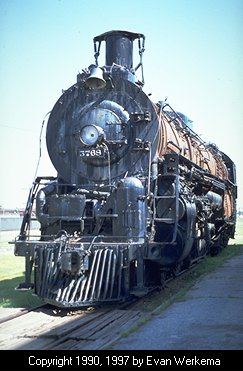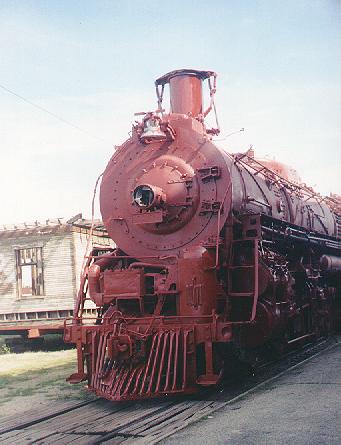History | |
|---|---|
| The 3768 was built by Baldwin in May of 1938 as the fourth member
of the 3765-class 4-8-4's (3765-3775). Oil-fired and equipped with 80-inch drivers, the
locomotives of this class were initially assigned to pulling passenger trains such as the
Chief and Fast Mail Express between La Junta, CO and Los Angeles, CA. The
locomotives frequently made the entire 1234 mile trip between those points without an
engine change - a matter of routine today, but quite a feat back then. Eventually bumped from passenger assignments by diesels, the 3765-class became freight haulers. Their last major assignment was hauling freight on the Eastern Division between Argentine (Kansas City, KS) and Waynoka, OK. According to Stagner (see reference 1 below), the 3768 made its last trip on August 4, 1953. In its short service life (by steam engine standards, anyway), the locomotive had racked up 1,779,162 miles - better than 100,000 miles per year. | |
 | The 3768 was the only member of its class to be preserved. It was donated to the City of Wichita, KS in May, 1958 and placed on display at Friends' University. In 1977 it was relocated to a display site near Wichita Union Station. In 1985 it became part of the Great Plains Transportation Museum. The photo at left shows the 3768 at the museum site in June of 1990, after the boiler lagging had been removed. While somewhat unsightly, removal of the lagging ridded the locomotive of asbestos, and prevented water from collecting in the insulation and rusting the carbon steel boiler beneath. Also note the telescoping stack extension. The 3765-class was one of several classes of Santa Fe steam locomotives equipped with air-operated stack extensions to help improve the draft in the firebox. The 2900-series 4-8-4's also had telescoping extensions, while other classes like the 5011-series 2-10-4's had shorter, flip-up extensions. |
 | Around 1996, the GPTM gave 3768 a fresh coat of paint. The photos at left and below, graciously provided by Richard Hitchcock, show the locomotive in red primer (left) and following repainting in flat black (below). |
 | |
Published Photographs of 3768 | |||||
|---|---|---|---|---|---|
| date | location | photographer | comments | reference | page |
| ? | Wootton, CO | Otto Perry | Triple heading Tr. 19, the westbound Chief over Raton Pass with 2-10-2's 3819 and 3822 | 5 | 88 |
| ? | Cajon, CA (Sullivan's Curve) | Herb Sullivan | with Tr. 20, the eastbound Chief | 3 | 73 |
| ? | Cajon Pass, CA | Herb Sullivan | Double heading the Chief with 4-4-2 #1468 | 9 | 232 |
| 2/14/40 | Ash Fork, AZ | ? | with Tr. 8, the eastbound Fast Mail Express | 6 | 223 |
| 12/15/40 | E. of San Bernardino, CA | Santa Fe Ry. | with Tr. 19, the westbound Chief | 4 | plate between p.210-211 |
| 9 | 316 | ||||
| 11/2/41 | Summit, CA | Richard Kindig | with Tr. 20, the eastbound Chief | 4 | plate between p.210-211 |
| 8 | 80 | ||||
| 10 | 29 | ||||
| 12/17/41 | Nelson, AZ | D.L. Ingersoll | with Tr. 8, the eastbound Fast Mail Express | 1 | 231 |
| 1952 | Newton, KS | Giles Stagner | roster shot | 7 | 2 |
| 11/52 | E. of Emporia, KS | James Burke | livestock and perishables train | 7 | cover |
References |
|---|
| 1. Colorado Rail Annual No. 23: Santa Fe in the Intermountain West, Boulder, CO: Colorado Railroad Historical Foundation, 1998. |
| 2. Description of Equipment on Display at the Great Plains Transportation Museum, museum flyer |
| 3. Drury, George H., Santa Fe in the Mountains, Waukesha, WI: Kalmbach Publishing Co., 1995. |
| 4. Farrington, Jr., S. Kip, The Santa Fe's Big Three, New York: David McKay Co., Inc., 1972. |
| 5. McCall, John, Santa Fe Early Diesel Daze, Dallas: Kachina Press, 1980. |
| 6. Myrick, David F., The Santa Fe Route: Railroads of Arizona Vol. 4, Wilton, CA: Signature Press, 1998. |
| 7. Stagner, Lloyd, Santa Fe Steam Finale in Kansas, 1952-55, David City, NB: South Platte Press, 1988. |
| 8. Walker, Chard, Cajon: Rail Passage to the Pacific, Glendale, CA: Transangelo Books, 1995. |
| 9. Worley, E. D., Iron Horses of the Santa Fe Trail, Dallas: Southwest Railroad Historical Society, 1965. |
| 10. Zimmerman, Karl, Santa Fe Streamliners, New York: Quadrant Press, 1987. |
Back to Santa Fe Preserved Locomotives